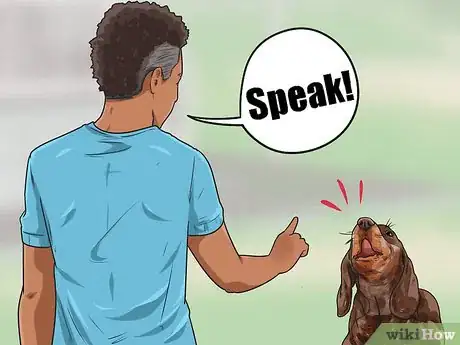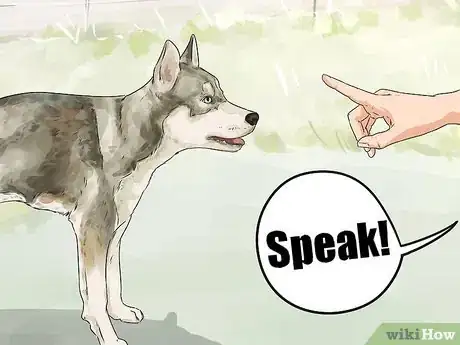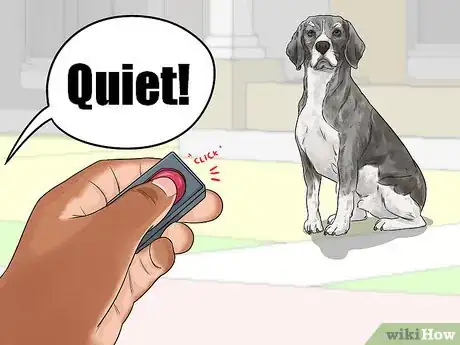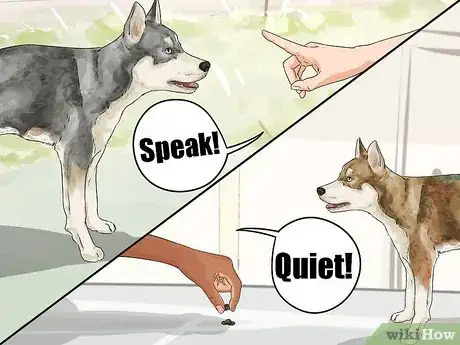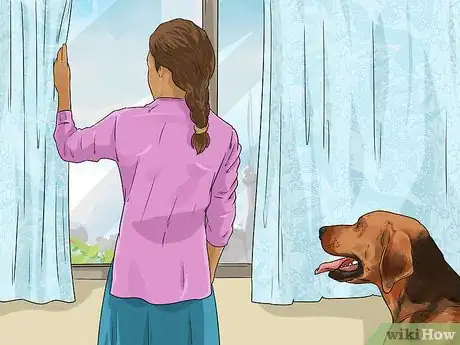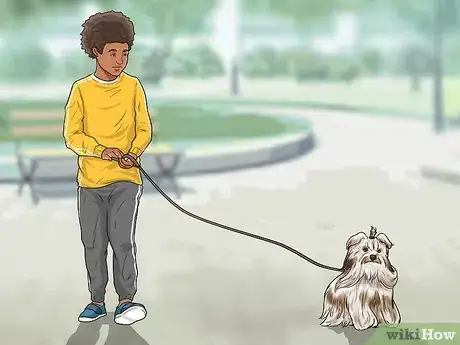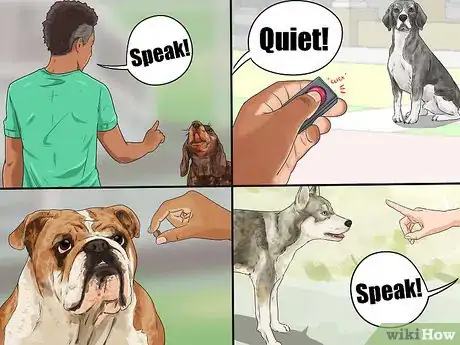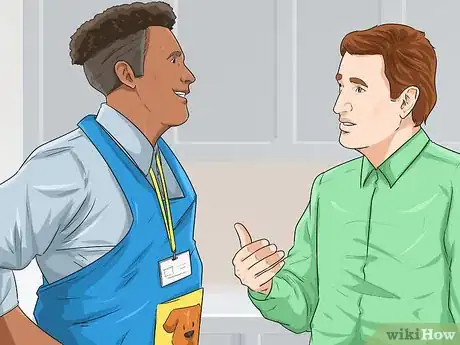This article was co-authored by Beverly Ulbrich. Beverly Ulbrich is a Dog Behaviorist and Trainer and the Founder of The Pooch Coach, a private dog training business based in the San Francisco Bay Area. She is a Certified CGC (Canine Good Citizen) Evaluator by the American Kennel Club and has served on the Board of Directors for the American Humane Association and Rocket Dog Rescue. She has been voted the best private dog trainer in the San Francisco Bay Area 4 times by SF Chronicle and by Bay Woof, and she has won 4 "Top Dog Blog" awards. She has also been featured on TV as a dog behavior expert. Beverly has over 18 years of dog behavior training experience and specializes in dog aggression and anxiety training. She has a Master of Business Administration from Santa Clara University and a BS from Rutgers University.
This article has been viewed 27,044 times.
Dogs will bark for a variety of reasons and it can be difficult to get your dog to resist their natural urge to bark. Your dog may start barking when they are feeling territorial, excited, playful, or want to get your attention. Dogs will also bark around other dogs as a way to be social and communicate with them.[1] You can teach your dog the “stop barking” command by first teaching him the “speak” command. Once you can control how often he speaks or barks, you can teach him how to stop barking when required. You can also learn how to prevent your dog from barking so he is less likely to be triggered and can stay calm.
Steps
Teaching Your Dog the “Speak” Command
-
1Command your dog to “speak.” Though it may seem counterintuitive, it is important that you start by getting your dog to learn the “speak” command. Doing this will allow you to control when your dog speaks or barks and when he is silent. Practice this command in a quiet place in your home with no distractions. Put a few treats in your pocket so they are on hand during the training session.[2]
- Start by telling your dog to “speak.” Wait for him to bark two to three times. Then reward the dog with a high value treat or a favorite toy to show it that you want this behavior.
-
2Trigger your dog to bark. If your dog does not bark when you command him to speak, you may try triggering him so he barks. Ring the doorbell to get him to bark or make a noise at the door. Once he starts barking, say “speak” and use a hand signal to encourage the barking.[3]
- You can use a hand signal like clapping or snapping. You can also use a clicker when you say “speak” if your dog uses clicker training.
Advertisement -
3Place a treat in front of your dog. Once your dog starts barking, place a treat in front of his nose. He should eventually stop barking to sniff the treat. Praise your dog with a “Good job” or “Good work” and give him the treat.[4]
- Repeat these actions several times until your dog starts barking when you say “speak”. You may also do the necessary hand gesture or click the clicker to trigger him to speak.
Teaching Your Dog the “Stop Barking” Command
-
1Encourage your dog to bark. Start by getting your dog to bark with the “speak” command. You want to make sure you can control when your dog barks with this command. It will make it easier for you to get your dog to stop barking if you can control when he barks.[5]
- If your dog struggles with the “speak” command, you may need to practice this command a bit more with your pup before you move on to the “stop barking” command. Be patient and give your dog time to learn the “speak” command before you move onto the “stop barking” command.
-
2Say “quiet” with a hand signal or a clicker. Once your dog starts barking, say “quiet.” Place a treat in front of his nose and wait for him to stop barking so he can sniff at the treat.[6]
- You may try practicing the “stop barking” command by the front door or by another area where your dog tends to bark uncontrollably. This can help to teach him that he needs to be quiet and stop barking no matter where he is in your home.
-
3Delay the reward until your dog is quiet. Let your dog see the treat but do not give it to him until he stops barking and is quiet. When he stops barking, give him the treat and praise him. You may say “Good job” or “Good work” and give him a pet on the head.[7]
-
4Put the cues together. Start by commanding your dog to “speak.” Then, put a treat in front of him and say “quiet.” Only give your dog the treat if he stops barking. You may need to repeat these cues several times to ensure your dog understands and has learned the commands.[8]
- You may also delay the reward for “quiet” for longer periods of time to ensure your dog understands that “quiet” means to stop barking for a continued stretch of time. You may delay the reward for 30 seconds and then for one minute to ensure your dog understands he needs to be quiet.
-
5Test the command. When you feel confident that your dog understands the “quiet” command, you should test it out. Have someone ring the doorbell or do something else that triggers your dog's barking while you and your dog are inside. Your dog will likely bark at the presence of someone at the door and at the sound of the doorbell. Say the “quiet” command to your dog. Wait for your dog to stop barking, even while the doorbell is ringing, and give him a treat as a reward.[9]
- You can also test this command at the dog park when the dog is around other dogs. You may do the “quiet” command when your dog spots another dog to ensure he does not bark.
Preventing Your Dog From Barking
-
1Remove your dog's motivations to bark. You can prevent your dog from barking by adjusting his environment so he is less likely to get agitated or territorial.[10] If your dog tends to bark at people passing by on the street from the window, close the curtains or the blinds so he cannot see outside and be triggered to bark. You may also try keeping your dog indoors when you are not home, as leaving your dog in the front yard or backyard can expose him to people and other triggers that can lead to barking.[11]
- Try not to get your dog riled up when someone is at the door as this can lead to barking. Do not ask, “Who's at the door?” or “Who's that?” when someone rings the bell. Instead, act calm and give the “quiet” command so your dog does not bark when someone is at the door.
- It is important for you to minimize the things your dog barks at by keeping a calm demeanor. If you treat things like they aren't a big deal, then so will your dog.
-
2Make sure you exercise your dog on a daily basis. A tired out dog is less likely to get agitated and bark at people at the door or people passing by.[12] You should take your dog for daily walks and have play sessions with him on a consistent basis. Doing this will ensure your dog is healthy and suitably worn out, which can make it easier for him to stay quiet and calm at home.[13]
- Smaller breeds may require only a short walk outside or around the neighborhood on a daily basis to go to the bathroom and get some exercise. Larger breeds may need longer walks outside and trips to the dog park to get some exercise.[14]
-
3Keep your commands and rules consistent. A big part of training your dog properly is sticking to the same commands and rules.[15] Changing up the rules can confuse your dog and lead to erratic behavior from your dog. Stick to the same commands and rules for your dog to ensure he behaves at his best and is not prone to barking.[16]
- You should also make sure everyone in your household also uses the same commands and rules for your dog. If you live with others, you may need to have a house meeting where you outline the rules for the dog so everyone is on the same page and agrees to stick to a consistent set of commands.
-
4See a certified trainer.[17] If your dog still struggles with the "stop barking" command, you may need to bring him to a certified trainer. The trainer can help your dog get used to the command and tell you about obedience techniques you can try with your dog. You can find a certified trainer by speaking to your vet or to other pet owners.
Expert Q&A
Did you know you can get expert answers for this article?
Unlock expert answers by supporting wikiHow
-
QuestionHow can I get my dog to stop barking at other dogs?
 Beverly UlbrichBeverly Ulbrich is a Dog Behaviorist and Trainer and the Founder of The Pooch Coach, a private dog training business based in the San Francisco Bay Area. She is a Certified CGC (Canine Good Citizen) Evaluator by the American Kennel Club and has served on the Board of Directors for the American Humane Association and Rocket Dog Rescue. She has been voted the best private dog trainer in the San Francisco Bay Area 4 times by SF Chronicle and by Bay Woof, and she has won 4 "Top Dog Blog" awards. She has also been featured on TV as a dog behavior expert. Beverly has over 18 years of dog behavior training experience and specializes in dog aggression and anxiety training. She has a Master of Business Administration from Santa Clara University and a BS from Rutgers University.
Beverly UlbrichBeverly Ulbrich is a Dog Behaviorist and Trainer and the Founder of The Pooch Coach, a private dog training business based in the San Francisco Bay Area. She is a Certified CGC (Canine Good Citizen) Evaluator by the American Kennel Club and has served on the Board of Directors for the American Humane Association and Rocket Dog Rescue. She has been voted the best private dog trainer in the San Francisco Bay Area 4 times by SF Chronicle and by Bay Woof, and she has won 4 "Top Dog Blog" awards. She has also been featured on TV as a dog behavior expert. Beverly has over 18 years of dog behavior training experience and specializes in dog aggression and anxiety training. She has a Master of Business Administration from Santa Clara University and a BS from Rutgers University.
Dog Behaviorist & Trainer If it's a very mild case, then you're best off just working with your dog in general on training and patience. If your dog is aggressive, then rather than trying to handle it yourself, you really do need to work with a professional. They can analyze why your dog is afraid or aggressive and work with you to develop a plan that handles the issue safely.
If it's a very mild case, then you're best off just working with your dog in general on training and patience. If your dog is aggressive, then rather than trying to handle it yourself, you really do need to work with a professional. They can analyze why your dog is afraid or aggressive and work with you to develop a plan that handles the issue safely. -
QuestionHow can I stop my dog from barking in the backyard?
 Beverly UlbrichBeverly Ulbrich is a Dog Behaviorist and Trainer and the Founder of The Pooch Coach, a private dog training business based in the San Francisco Bay Area. She is a Certified CGC (Canine Good Citizen) Evaluator by the American Kennel Club and has served on the Board of Directors for the American Humane Association and Rocket Dog Rescue. She has been voted the best private dog trainer in the San Francisco Bay Area 4 times by SF Chronicle and by Bay Woof, and she has won 4 "Top Dog Blog" awards. She has also been featured on TV as a dog behavior expert. Beverly has over 18 years of dog behavior training experience and specializes in dog aggression and anxiety training. She has a Master of Business Administration from Santa Clara University and a BS from Rutgers University.
Beverly UlbrichBeverly Ulbrich is a Dog Behaviorist and Trainer and the Founder of The Pooch Coach, a private dog training business based in the San Francisco Bay Area. She is a Certified CGC (Canine Good Citizen) Evaluator by the American Kennel Club and has served on the Board of Directors for the American Humane Association and Rocket Dog Rescue. She has been voted the best private dog trainer in the San Francisco Bay Area 4 times by SF Chronicle and by Bay Woof, and she has won 4 "Top Dog Blog" awards. She has also been featured on TV as a dog behavior expert. Beverly has over 18 years of dog behavior training experience and specializes in dog aggression and anxiety training. She has a Master of Business Administration from Santa Clara University and a BS from Rutgers University.
Dog Behaviorist & Trainer
-
QuestionDo dogs get bored?
 Beverly UlbrichBeverly Ulbrich is a Dog Behaviorist and Trainer and the Founder of The Pooch Coach, a private dog training business based in the San Francisco Bay Area. She is a Certified CGC (Canine Good Citizen) Evaluator by the American Kennel Club and has served on the Board of Directors for the American Humane Association and Rocket Dog Rescue. She has been voted the best private dog trainer in the San Francisco Bay Area 4 times by SF Chronicle and by Bay Woof, and she has won 4 "Top Dog Blog" awards. She has also been featured on TV as a dog behavior expert. Beverly has over 18 years of dog behavior training experience and specializes in dog aggression and anxiety training. She has a Master of Business Administration from Santa Clara University and a BS from Rutgers University.
Beverly UlbrichBeverly Ulbrich is a Dog Behaviorist and Trainer and the Founder of The Pooch Coach, a private dog training business based in the San Francisco Bay Area. She is a Certified CGC (Canine Good Citizen) Evaluator by the American Kennel Club and has served on the Board of Directors for the American Humane Association and Rocket Dog Rescue. She has been voted the best private dog trainer in the San Francisco Bay Area 4 times by SF Chronicle and by Bay Woof, and she has won 4 "Top Dog Blog" awards. She has also been featured on TV as a dog behavior expert. Beverly has over 18 years of dog behavior training experience and specializes in dog aggression and anxiety training. She has a Master of Business Administration from Santa Clara University and a BS from Rutgers University.
Dog Behaviorist & Trainer
References
- ↑ http://dogtime.com/dog-health/general/675-barking-aspca#GzjSc1ZUzUoLORJl.99
- ↑ http://www.humanesociety.org/animals/dogs/tips/how_to_stop_barking.html
- ↑ http://www.dogster.com/lifestyle/how-to-teach-your-dog-the-stop-barking-command
- ↑ http://www.humanesociety.org/animals/dogs/tips/how_to_stop_barking.html
- ↑ http://www.humanesociety.org/animals/dogs/tips/how_to_stop_barking.html
- ↑ http://www.humanesociety.org/animals/dogs/tips/how_to_stop_barking.html
- ↑ http://www.humanesociety.org/animals/dogs/tips/how_to_stop_barking.html
- ↑ http://www.dogster.com/lifestyle/how-to-teach-your-dog-the-stop-barking-command
- ↑ http://www.humanesociety.org/animals/dogs/tips/how_to_stop_barking.html
- ↑ Beverly Ulbrich. Dog Behaviorist & Trainer. Expert Interview. 30 January 2020.
- ↑ http://www.humanesociety.org/animals/dogs/tips/how_to_stop_barking.html
- ↑ Beverly Ulbrich. Dog Behaviorist & Trainer. Expert Interview. 30 January 2020.
- ↑ http://www.humanesociety.org/animals/dogs/tips/how_to_stop_barking.html
- ↑ Beverly Ulbrich. Dog Behaviorist & Trainer. Expert Interview. 30 January 2020.
- ↑ Beverly Ulbrich. Dog Behaviorist & Trainer. Expert Interview. 30 January 2020.
- ↑ http://dogtime.com/dog-health/general/675-barking-aspca
- ↑ Beverly Ulbrich. Dog Behaviorist & Trainer. Expert Interview. 30 January 2020.
About This Article
To teach your dog the "stop barking" command, start by teaching it how to “speak” so you can control when it's allowed to bark. Start by putting some treats in your pocket, telling your dog to “speak” while triggering the action with a knock or doorbell, and rewarding it when it barks. Once your dog is barking on command, place a treat in front of its nose while it's barking to get it to stop and sniff. Then, say “quiet” as soon as it stops barking, and give it the reward. When you feel confident that your dog understands "quiet," have someone ring the doorbell, give the command, and reward your dog when it stops barking. For more tips from our Veterinary co-author, including how to remove your dog’s motivations for barking, keep reading!
